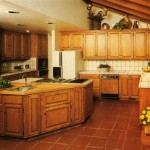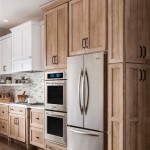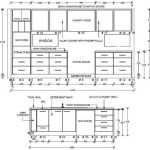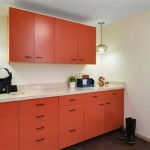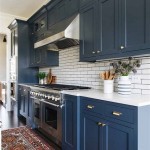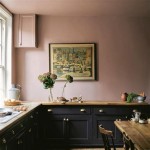Wood Kitchen Cabinets with White Countertops: A Timeless Aesthetic
The combination of wood kitchen cabinets with white countertops represents a design choice that has remained consistently popular for decades. This enduring appeal stems from its inherent versatility, balance, and the ability to create a kitchen space that is both inviting and aesthetically pleasing. The natural warmth of wood harmonizes seamlessly with the clean, bright look of white countertops, resulting in a kitchen that is both classic and modern. This article will explore the various aspects of this design pairing, including wood types, countertop materials, style considerations, and practical design tips for achieving a successful and visually captivating kitchen.
The aesthetic benefits of this combination are numerous. Wood, in its diverse range of tones and grains, introduces a sense of natural warmth and texture to the kitchen. From the light, airy feel of maple to the rich, deep tones of cherry or walnut, each wood species contributes a unique character. White countertops, conversely, offer a clean, bright surface that reflects light, making the kitchen feel more spacious and open. The contrast between the two materials provides visual interest and prevents the space from feeling either too sterile or too heavy.
Furthermore, this design scheme offers excellent flexibility in terms of style. It can be adapted to suit a variety of kitchen aesthetics, from traditional and farmhouse to modern and contemporary. The choice of wood species, countertop material, hardware, and accessories will ultimately determine the overall style of the kitchen. This adaptability is a key reason for its enduring popularity among homeowners and designers alike.
Key Considerations for Wood Cabinet Selection
Selecting the right type of wood for kitchen cabinets is crucial in achieving the desired aesthetic and ensuring durability. Several factors come into play, including the wood's color, grain pattern, hardness, and cost. Each wood species offers a distinct appearance and performance characteristic that should be carefully considered in relation to the overall kitchen design.
Maple: Maple is a light-colored hardwood with a fine, uniform grain. It is a popular choice for modern and contemporary kitchens due to its clean and understated appearance. Maple is also a relatively hard and durable wood, making it suitable for high-use areas like kitchens. Its light color makes it easy to stain in a variety of shades, offering versatility in design. Maple cabinets can easily be paired with white countertops to create a bright and airy kitchen atmosphere.
Oak: Oak is a classic choice for kitchen cabinets, known for its distinctive grain pattern and durability. It is a hardwood with a prominent grain that can add character to a kitchen. Oak is also a relatively affordable option compared to some other hardwoods. Oak cabinets are often paired with white countertops in traditional and farmhouse-style kitchens, creating a warm and inviting atmosphere. Oak can be stained in various colors, from light to dark, allowing for a range of design possibilities.
Cherry: Cherry is a reddish-brown hardwood with a smooth, even grain. It is a more expensive option than maple or oak but offers a richer, more sophisticated look. Cherry cabinets are often used in traditional and transitional kitchens. Over time, cherry wood will naturally darken, adding to its character and depth. When paired with white countertops, cherry cabinets create a striking contrast and a luxurious feel.
Walnut: Walnut is a dark brown hardwood with a distinctive grain pattern. It is a premium wood that adds a touch of elegance and sophistication to any kitchen. Walnut cabinets are often used in modern and contemporary kitchens. Walnut is a durable wood that can withstand daily use. When paired with white countertops, walnut cabinets create a dramatic and visually stunning effect.
Beyond the primary wood species, the cabinet door style also contributes to the overall aesthetic. Shaker-style doors, known for their clean lines and simplicity, are a versatile choice that complements both traditional and modern designs. Raised-panel doors, with their more ornate detailing, are a better fit for traditional kitchens. Slab doors, characterized by their flat surfaces, are ideal for contemporary and minimalist kitchens. The careful selection of both the wood species and door style is essential for creating a cohesive and visually appealing kitchen design.
Countertop Material Options and Considerations
The choice of countertop material is equally important as the wood cabinet selection. White countertops are available in a variety of materials, each with its own unique characteristics, including price, durability, maintenance requirements, and aesthetic qualities. Understanding the pros and cons of each material is crucial for making an informed decision that meets both functional needs and design preferences.
Quartz: Quartz is an engineered stone made from crushed quartz crystals and resin. It is a highly durable and low-maintenance option for kitchen countertops. Quartz is resistant to scratches, stains, and heat, making it ideal for busy kitchens. It is also available in a wide range of white colors and patterns, including solid white, marble-look, and speckled designs. Quartz countertops are a popular choice for both modern and traditional kitchens.
Granite: Granite is a natural stone that is known for its beauty and durability. It is a popular choice for kitchen countertops, offering a unique and natural look. While primarily thought of as speckled or multicolored, granite is available in several shades of white and off-white, often with subtle veining or mineral deposits. Granite is heat resistant and scratch resistant, though it requires sealing to prevent staining from spills. It is a robust option creating a sense of luxury.
Marble: Marble is a natural stone that is prized for its elegance and beauty. It is a softer stone than granite or quartz and is more susceptible to scratches and stains. Marble countertops require regular sealing and care to maintain their pristine appearance. Nonetheless, the luxurious look and unique veining of marble make it a popular choice for high-end kitchens. White marble countertops, such as Carrara or Calacatta, are particularly desirable, adding a touch of sophistication and timeless elegance.
Laminate: Laminate is a more affordable option for kitchen countertops. It is made from layers of paper and resin that are bonded to a particleboard core. Laminate countertops are available in a wide range of colors and patterns, including white. While laminate is not as durable as quartz or granite, it is relatively easy to clean and maintain. It's a practical choice for budget conscious homeowners seeking the aesthetic of white countertops.
Solid Surface: Solid surface countertops are made from acrylic or polyester resins. They are non-porous and seamless, making them easy to clean and maintain. Solid surface countertops are also available in a variety of white colors and patterns. They are resistant to stains and scratches but can be damaged by heat. Solid surface countertops are a mid-range option that offers a good balance of durability and affordability.
When selecting a white countertop material, consider the overall style of the kitchen, the budget, and the desired level of maintenance. Quartz and granite are excellent choices for durability and low maintenance, while marble offers a luxurious and elegant look. Laminate and solid surface are more affordable options that still provide a clean and bright aesthetic.
Design Considerations and Practical Tips
Beyond the selection of wood cabinets and countertop materials, several other design considerations contribute to the success of a kitchen featuring this combination. These include hardware selection, backsplash design, lighting choices, and the overall color palette of the kitchen. By carefully considering these elements, it is possible to create a kitchen that is both beautiful and functional.
Hardware: The hardware on the cabinets can significantly impact the overall style of the kitchen. Brushed nickel or stainless steel hardware provides a modern and contemporary look, while brass or bronze hardware adds a touch of warmth and tradition. Black hardware offers a bold contrast against both the wood cabinets and white countertops, creating a striking visual effect. The choice of hardware should complement the other design elements in the kitchen and reflect the homeowner's personal style.
Backsplash: The backsplash provides an opportunity to add color, texture, and visual interest to the kitchen. A classic white subway tile backsplash is a timeless choice that complements both wood cabinets and white countertops. Glass tile backsplashes offer a sleek and modern look, while mosaic tile backsplashes add a touch of artistry and personality. The backsplash can be used to tie together the different design elements in the kitchen and create a cohesive and harmonious look. Using a contrasting color to the countertop can give it a more modern appearance.
Lighting: Proper lighting is essential for both functionality and aesthetics in the kitchen. Under-cabinet lighting illuminates the countertops, making food preparation easier and safer. Recessed lighting provides general ambient lighting, while pendant lights add a decorative touch and highlight specific areas, such as the kitchen island or breakfast bar. Natural light is also an important factor, and maximizing the amount of natural light in the kitchen can make the space feel more open and inviting.
Color Palette: While the wood cabinets and white countertops provide a neutral base, the overall color palette of the kitchen should be carefully considered. Adding pops of color through accessories, such as dishware, artwork, and textiles, can add personality and visual interest. A cohesive color scheme will create a more harmonious and inviting space. Consider using complementary colors to create balance, or analogous colors for a more subtle effect.
In conclusion, the combination of wood kitchen cabinets with white countertops remains a highly desirable design choice due to its versatility, timeless appeal, and ability to create a welcoming and functional kitchen space. By carefully considering the wood species, countertop material, hardware, backsplash, lighting, and color palette, it is possible to create a kitchen that reflects the homeowner's individual style and meets their specific needs. The juxtaposition of the natural warmth of wood against the clean brightness of white countertops is a winning combination that will continue to be a popular choice for years to come.

10 Inspiring Kitchens With Wood Cabinets And White Countertops Kitchen Cabinet Design Renovation Inspirations

5 Latest Fresh Looks For Natural Wood Kitchen Cabinets

5 Stunning Ways To Pair Wood Kitchen Cabinets With White Countertops Cambria Quartz Surfaces

21 Diy Affordable Ways To Redo Kitchen Cabinets Extra Space Storage

Rustic Kitchen By Crown Point Cabinetry Cabinets Cabinet Design Renovation

5 Latest Fresh Looks For Natural Wood Kitchen Cabinets

54 Light Wood Kitchen Cabinets Natural Look

The Return Of Natural Wood Kitchen Cabinets

The Comeback Of Wood Kitchen Cabinets Farmhousehub

Best Countertop For Stained Wood Cabinets Maria Killam
Related Posts

